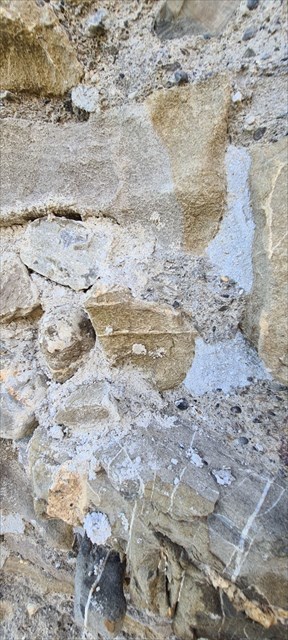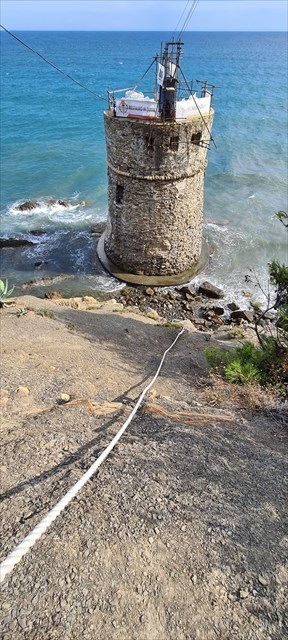Restoration work in progress. Wait till the workman are not around (holidays, weekend or at the end of the day)
Saracene tower (Imperia)
“E tutte il mare spinge le mugghianti Collere a questo bastion di scogli” (and the whole sea pushes the bubbling rage to this bastion of rocks)” (G. Carducci).
The Torre di Prarola at the mouth of the Prino torrent was part of the vast defensive system ordered by the Republic of Genoa in the sixteenth century. In that periode there was the Franco-Spanish conflict, in which the Turks joined the French in 1535, followed in 1543 by the continuous barbarian raids of the hordes of pirates who invaded the coastal villages of the North African coast to raid and enslave the inhabitants. And even though the Saracen invasions that had tormented the region in the ninth and tenth centuries were long gone, the memory of it was still alive among the people here. The notorious pirate Barbarossa started raiding the Ligurian coast from 1543, followed by pirate Ali who invades Santo Stefano al Mare. They were followed by pirate Dragut, who raided the hinterland of Porto Maurizio and pirate "Lazzaro Calabrese", alias Giovanni Galeni.
The need grew for defensive structures starting from the Genoa to Corsica and the Riviera and the Republic ordered the local communities take care of this. Therefore, each manufacturer follows personal evaluation criteria, according to local needs and morphological characteristics. This is the reason why you find is a wide variety of shapes along the coast and height of these “Saracen” towers.
The towers, located along the coast or in conspicuous points of the immediate inland, have the dual function of defense of the territory and of signaling, communicating the arrival of the enemy to the towers located along the same chain of sighting, by means of daytime smoke or night fires, according to a regulation of the Republic.
The Tower of Prarola, built between 1562 and 1564 on the cliffs west of Imperia - for this particular unusual position similar to the Torre Scuola, off the Palmaria, and the castle of Rapallo - was in direct visual connection with the bell tower of Oratory of Porto Maurizio, from which probably the reports were "rebounded" within the territory, through other towers.
Similar to other artifacts in the area, it has a circular plan (which is elsewhere polygonal) and a thick wall, executed "a sack", that is with filling of local stones between the internal wall and the external wall; the internal and external walls are treated with white lime to make them waterproof, while the external face is a shoe, to give greater strength to the most accessible part. At the apex of the shoe, about eight meters high, there is the typical curves of the sixteenth-century fortifications, above which there is a parapet of about three meters, to protect the guard and the batteries, partially protected by a cap. The entrance is narrow and raised above the surrounding ground.
Restoration
The oldest documents date back to 1855, when the tower was declared unusable and was then transferred from the military administration to the Administration of Finance, which in turn handed the building to the State by virtue of its alleged monumental interest. The Minister of Public Instruction therefore assigned to the Superintendent of the Monuments of Piedmont and Liguria the task of ascertaining this circumstance. In 1910, the Genoa Regional Office prepared an inspection, from which emerged the conditions of deterioration and precariousness of the Tower, eroded by the sea, subjected to the pressure of the waves, invaded inside by water, deprived of the covering cap.
A postcard (with the verses of Carducci), dated 1911, incorporates the tower from the west: the brickwork appears to be corroded, while the residual pieces of plaster on the parapet and on the cap partially covering the "terrace" are evident. The angle of view justifies the non-falling aspect of the artifact which, in the following images, taken from the opposite side, appears much more degraded.
On the other hand, the north-west side is the most protected with respect to the action of atmospheric agents and the sea (private collection).
A practical problem during the restoration of the tower was the fact that the tower was 20 m lower than the coastal road, and it’s isolated position on the cliff, surrounded by the sea. Therefor the building materials had to be transported locally, creating a special wooden slide from the road to the base of the Tower.
In 1913, cost estimates and technical reports on the methods of restoration appear, but is quiet sure that the actual restoration was not carried out. In 1940, the emergency was discussed again in joint reports by the Monuments Superintendency of Liguria and the Ministry of Public Works, but the war delays restoration again.
Between 1950 and 1952, the partial reconstruction of the submerged and emerged masonry took place, with the creation of a containment curb at the base of the Tower, with the consolidation of the covering cap. The operation was effective, as was concluded in the 1970’s. However, the cording at the base of the Tower was heavily affected by erosion, while the rising sea level exposed more of the structure to the pressure of the waves.
A reinforced concrete pitch with a service ladder that reaches the base of the Tower was built on the above Via Aurelia, to facilitate the procurement of materials that would not be possible from the sea due to the presence of submerged rocks. A formwork is prepared in which pozzolanic concrete is poured onto a stainless steel armature (both materials can not be attacked by the saline), and the old containment curb at the base of the tower was reconstituted and enlarged. The tower and cap are waterproof now.
As we speak there is another restauration taking place. During this restauration a lot of old holes are filled with concrete. One of these holes held (or better: still holds) the former cache …

During the restauration work the tower is closed with a metal gate with a lock. Hopefully the lock and the gate will be removed when the restauration is finished.
The cache
This old fortification locally known as "Saracen Tower" is located in the middle of the sea near Imperia, at the base of a steep cliff. A fabulous site. You can reach it by a steep, slippery path, from the road above. You can climb the tower and have a great view on the old city of Imperia.
Parking is difficult. You can only park a bike next to the road. If you come by car it’s better to park near the sea at Imperia and walk to the cache at the side of the road. From the parking it’s only 500 meter. Mind the traffic!
When the staircase stops, use the white rope to descent further down.

At the end of the white rope there is a black rope, but you don’t really need that one. At the end of the black rope is a plastic rope. Again, you can use it, but it’s not necessary. At the bottom of the cliff cross the water to to the base of the tower (you can use the big stones to stay dry) and climb the metal stairs.
Look for a green waterproof container, just before you should enter the tower, covered with rocks. Leave the cache as you found it, or better, is it was not hidden properly.
It's not necessary to take great risks to find this cache (apart from reaching the tower itself. You don't have to climb down inside the tower or on top of the tower. Use common sense to find the cache And be careful. Know your limits. A DNF if better than DNS (did not survive ;-) ).
P.S. The local people come here to swim and sun on top of the tower, so it can be done ...
Happy caching!
Marrakesj